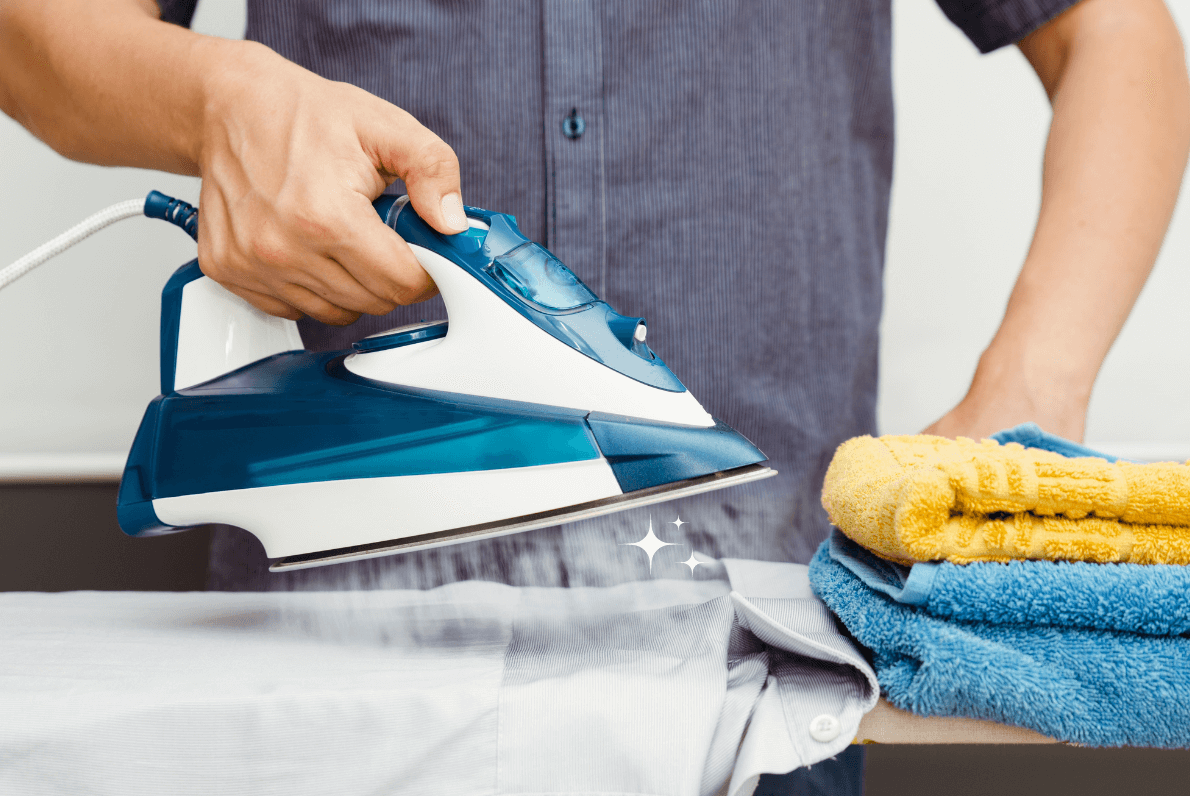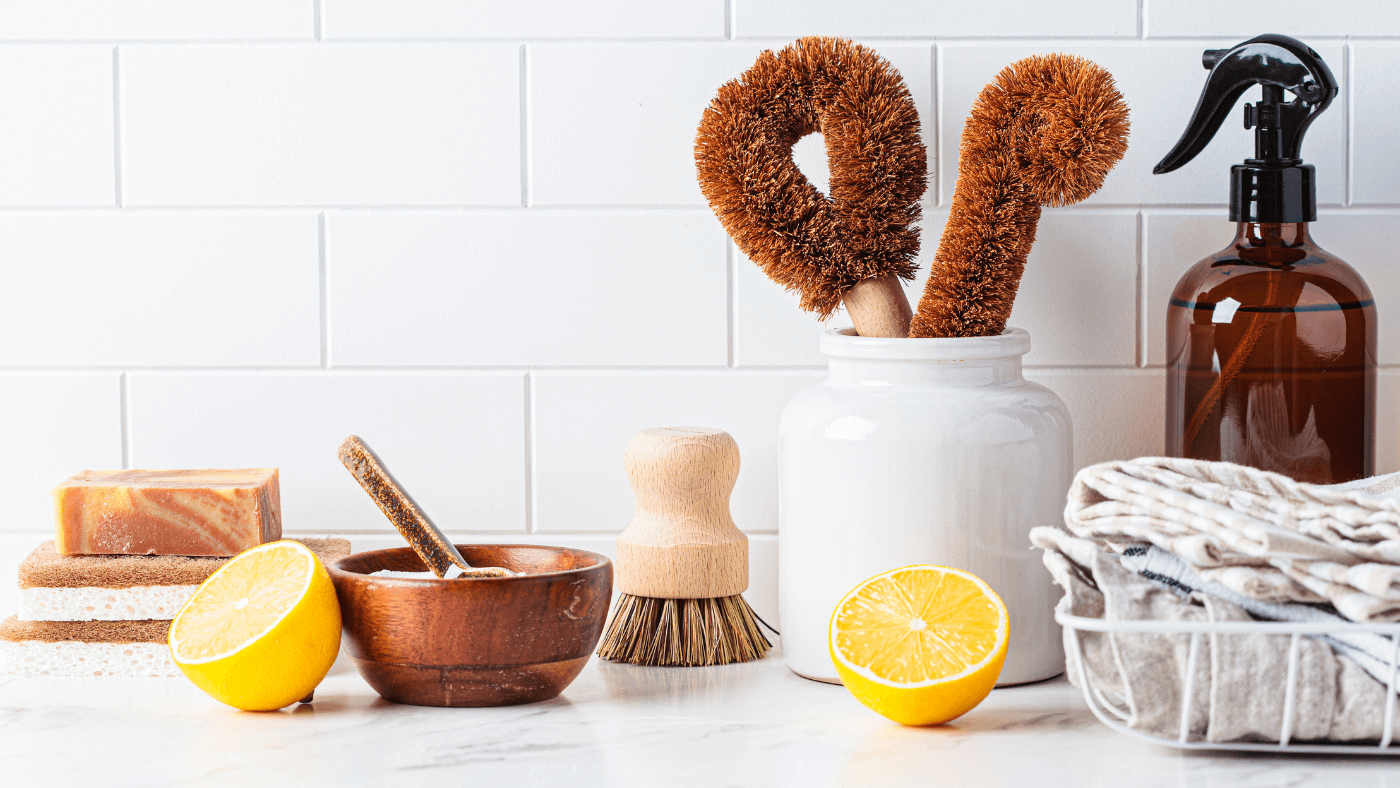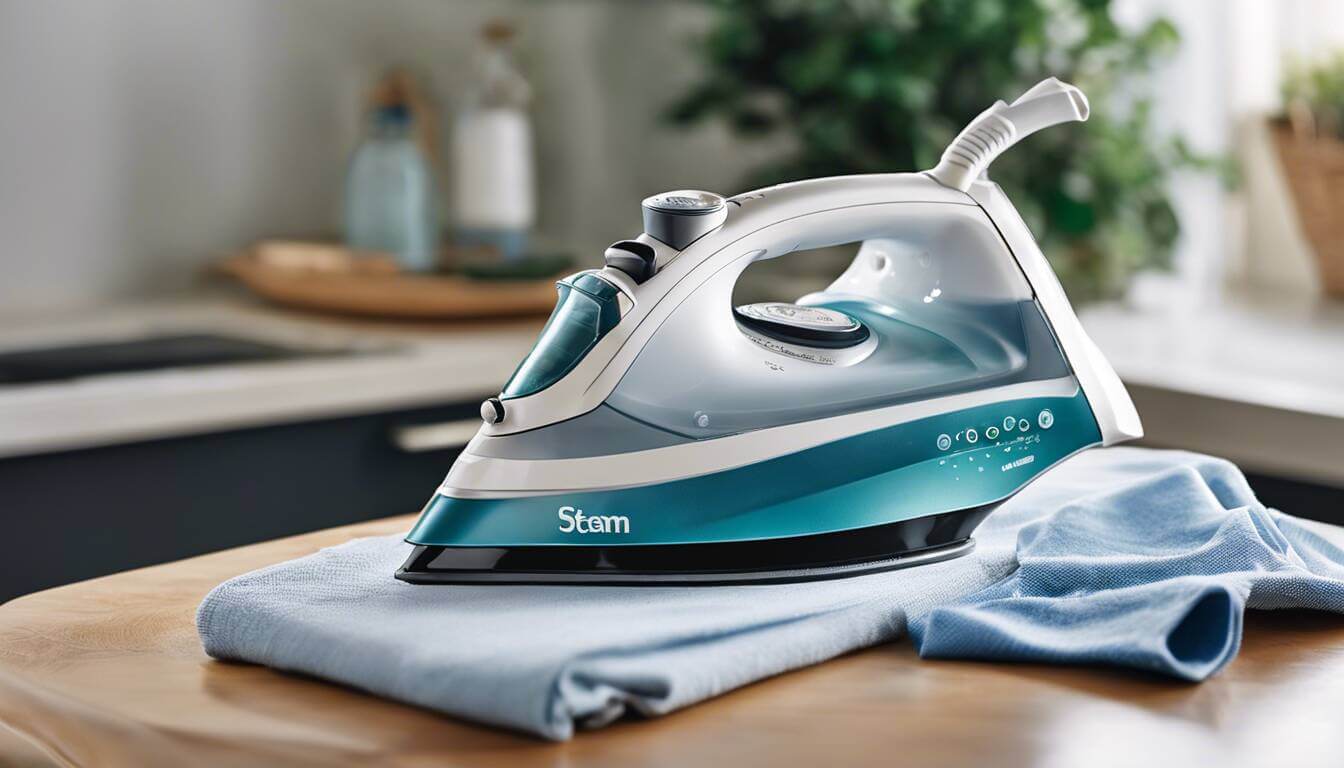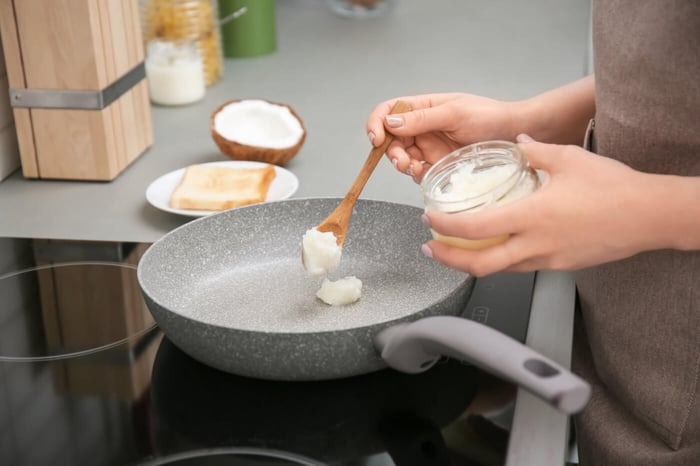
Have you ever been frustrated with a sticky iron that refuses to glide smoothly across your clothes? Fear not, we have the solution! In this blog post, we will guide you through various methods on how to clean a sticky iron and restore its pristine condition. We will also provide alternate solutions, such as using The Nori Press for ironing your clothes instead, so that you'll never have to deal with iron gunk ever again!
Say goodbye to the days of struggling with a stubborn iron and hello to a seamless ironing experience.
Identifying the Sticky Culprit

Before we explore cleaning techniques, it’s important first to pinpoint what’s causing the sticky residue on your iron. Gunk buildup on the hot plate of a sticky iron is usually caused by:
-
pressing the iron to the adhesive side of the interfacing
-
dust
-
fabric softeners
-
the melting of synthetic fibers
Mineral deposits from hard water can also contribute to the buildup on your iron plate.
These factors may contribute to a sticky or oily soleplate on a cool iron. Knowing the type of gunk on your iron will help you choose the best cleaning method and ensure you have a gunk-free ironing experience.
Regular iron cleanups are necessary to ensure its smooth glide across fabrics. A clean iron plate will not only make ironing more manageable but also extend the life of your iron and protect your clothes from unsightly stains or damage. So let’s explore different cleaning techniques to restore your iron to its best condition.
Removing Sticky Residue with Vinegar and Salt

One of the most effective methods to remove sticky residue from your iron plate is using a vinegar and salt solution. This simple yet powerful cleaning agent can help you get rid of stubborn gunk without causing any damage to your iron.
The vinegar and salt solution acts as an abrasive cleaner, effectively breaking down stubborn gunk on the iron plate.
Next, we’ll walk you through the steps of creating the solution, cleaning the iron soleplate, and the final wipe and rinse.
Preparing the Solution
Start by mixing vinegar and salt in a glass bowl to make the solution. The ratio of vinegar to salt may be adjusted to suit the desired strength. Stir the mixture until the salt has dissolved completely.
Once your solution is ready, you can proceed to clean your iron with this potent mixture.
Cleaning the Iron Soleplate
Before cleaning your iron, ensure it is unplugged and cool. Dip a clean cloth into your previously prepared vinegar and salt solution to clean the iron soleplate.
Gently wipe the soleplate of the iron with the cloth, focusing on any areas with buildup or stains. Be patient, as it may take some time for the vinegar and salt mixture to break down the stubborn gunk.
Wiping and Rinsing
Once you've cleaned the iron soleplate with the vinegar and salt solution, proceed to wipe and rinse. Use a cloth moistened with water to remove any remaining residue from the iron plate.
Rinse the iron plate with clean water to ensure all traces of the vinegar and salt solution are gone. Your iron is now clean and ready to glide smoothly across your clothes once again.
Utilizing Baking Soda for a Deep Clean

If you’re looking for a deep clean to remove even the most stubborn gunk from your iron plate, a baking soda paste might be the perfect solution. This method is particularly useful for iron plates with significant buildup or hard-to-remove stains.
This method is safe for irons with a non-stick coating, ensuring that the surface remains intact while removing gunk.
Next, you’ll learn how to create the baking soda paste, apply it to the iron plate, and finalize the process.
Making the Baking Soda Paste
For making the baking soda paste, you'll require baking soda and either vinegar or water. For a vinegar-based paste, use a 1:2 ratio of baking soda to vinegar. For a water-based paste, use a ratio of 3/4 cup baking soda to 1/4 cup warm water.
Mix the ingredients until a paste is formed. With your baking soda paste ready, you can now proceed to apply it to your iron plate.
Applying the Paste to the Iron Plate
Make sure your hot iron is unplugged and cool before you apply the baking soda paste. Spread the paste over the iron's soleplate using a damp cloth. Be cautious not to get the paste in the steam holes or other delicate areas.
Allow the paste to sit for a few minutes, letting it work its magic on the gunk and stains.
Finishing Touches
Once the baking soda paste has done its job on the gunk, you can complete the cleaning process. Wipe the iron plate with a damp cloth to remove the paste and any remaining residue.
Rinse the iron plate with clean water to ensure all traces of the baking soda paste are gone. With your iron now clean and gunk-free, you'll notice a significant improvement in its performance.
Magic Eraser: A Quick and Effective Method
For those who prefer a quick and effective method to clean their sticky iron, the Magic Eraser is an excellent choice. This cleaning tool can remove long-term built-up brown gunk from your iron with ease. The Magic Eraser acts as a powerful cleaning solution, easily removing long-term built-up gunk from your iron. The Magic Eraser method has proven to be highly effective with no drawbacks.
To use the Magic Eraser, simply dampen it with water and gently scrub the iron’s soleplate. Be sure to unplug your iron and let it cool before using the Magic Eraser. You’ll be amazed at how quickly and effectively this method can remove even the most stubborn gunk from your iron.
Cleaning Melted Plastic from the Iron Plate

Accidents can happen, and sometimes your iron may come into contact with plastic, leaving a melted mess on the iron plate. Don’t worry – there’s a simple way to remove melted plastic from your iron plate using fusible interfacing.
First, unplug your iron and allow it to reach an iron-cool temperature. Then, use ice cubes and a plastic knife to harden and scrape away the plastic quickly. Once the plastic has hardened, gently scrape it away with the plastic knife.
To finish cleaning the iron plate, wipe down the surface with vinegar spray or a damp rag. This method will effectively remove melted plastic from your iron plate, allowing you to continue ironing without damaging your clothes.
Maintaining Steam Vents and Water Reservoir
Beyond cleaning the iron plate, maintenance of the steam vents and water reservoir is vital for the optimal functioning of your iron. Regular maintenance can prevent mineral buildup, ensuring your iron’s steaming function works as it should.
Next, we’ll show you how to clean the steam vents with cotton swabs and vinegar, and how to flush the water reservoir using a vinegar and water mixture.
Cleaning Steam Vents
You'll need cotton swabs and distilled white vinegar to clean the steam vents of your iron. Dip the cotton swabs in vinegar and gently clean the steam holes. Be cautious not to push the cotton swabs too far into the steam holes, as this may cause damage.
This method will effectively remove any mineral scale buildup in the steam vents, ensuring your iron's steaming function works efficiently.
Flushing the Water Reservoir
It's necessary to flush the water reservoir to avoid mineral buildup and sustain your iron's performance. To do this, follow these steps:
-
Mix half a cup of white vinegar with half a cup of water.
-
Pour the mixture into the reservoir of a cool, unplugged iron.
-
Ensure that the iron is plugged into a power outlet.
-
Set the iron to steam mode and press the steam button several times until you get an unaffected steam flow.
Unplug the iron. Allow it to cool completely. Empty out the water and vinegar mixture. This simple maintenance step will keep your iron's water reservoir clean and functional.
Dryer Sheet Trick: An Alternative Cleaning Method
The dryer sheet trick, which utilizes fabric softener sheets, is another alternative method to remove gunk from your iron. This method is quick, simple, and doesn’t require any harsh chemicals. Additionally, dryer sheets are affordable and can be reused multiple times, making this an economical cleaning solution. After using the dryer sheet, you can wipe the iron with a dry cotton towel or paper towel to ensure it’s completely clean.
For cleaning your iron with the dryer sheet trick, follow these steps:
-
Adjust your iron to its lowest temperature.
-
Rub the soleplate using dryer sheets.
-
When a dryer sheet gets too hot, discard it and use a new one.
-
Continue this process until the iron is clean.
This method is an excellent alternative for those looking for a quick and cost-effective way to clean their sticky iron.
Preventive Measures for a Gunk-Free Iron

Even though cleaning your iron is necessary, adopting preventive measures can help prevent gunk buildup from the start. To keep your iron gunk-free, you can:
-
Use distilled or filtered water instead of tap water to fill the reservoir, as tap water may contain minerals that lead to buildup.
-
Empty the water reservoir after each use to prevent mineral deposits from forming.
-
Avoid using starch or fabric softeners on clothes that will be ironed, as these can contribute to gunk buildup.
Regularly clean your iron according to the manufacturer’s instructions and store it in a clean and dry place. Taking these preventive measures will not only help you maintain a gunk-free iron, but also prolong your iron’s lifespan and ensure smooth ironing sessions.
Summary
In conclusion, keeping your iron clean and gunk-free is essential for smooth ironing sessions and prolonging your iron's lifespan. Wondering how to clean a sticky iron? With various cleaning methods such as vinegar and salt, baking soda paste, Magic Eraser, and the dryer sheet trick, you'll find the perfect solution to tackle any stubborn gunk on your iron. Don't forget to maintain the steam vents and water reservoir to ensure optimal iron performance. By taking preventive measures and regularly cleaning your iron, you'll enjoy a seamless ironing experience and protect your clothes from unsightly stains or damage.
When you are ready for an upgrade, we recommend you ditch your old iron and ironing board and Try The Nori Press !
Frequently Asked Questions
What causes an iron to get sticky?
A sticky iron is often caused by using too hot a setting while ironing, which can melt fabric onto the plate, or by dirt and limescale build-up on the soleplate.
Cleaning the soleplate with a wet rag dipped in water or vinegar can help solve this problem.
How do you clean a sticky iron with baking soda?
Clean a sticky iron with baking soda by mixing two parts baking soda and one part water into a paste. Spread the paste on the iron plate, avoiding the steam vents, then leave for a few minutes and scrub with a clean toothbrush.
Finally, use a damp microfiber cloth to wipe clean.
What can be used on sticky iron?
Creating a paste with baking soda and water, as well as using baby powder, are great ways to tackle sticky iron.
Make sure to use filtered or diluted water to get the best results.
What is the black sticky stuff on my iron?
The black stuff on your iron is most likely the result of burn marks, dirt, dust, spray starch and fabric fiber buildup, as well as possible rust spots due to leaving water inside the appliance.
How can I remove gunk from my iron using vinegar and salt?
Mix vinegar and salt in a glass bowl, apply the solution to the iron plate with a clean cloth, and rinse with clean water to remove gunk from your iron.
Key Takeaways
-
Identify the cause of sticky residue on an iron plate to find the best cleaning method.
-
Utilize vinegar and salt solution, baking soda paste, or Magic Eraser for deep cleaning.
-
Take preventive measures like using distilled water & emptying the reservoir after use to maintain a gunk-free iron.
Are You Tired of Old Sticky Irons?
Maybe It's Time to Try The Nori Press!
Ready to upgrade your iron? Try the Nori Press today for easy ironing!




![How to Get Highlighter Out of Clothes [20 DIY Tips] – Nori Press](https://dropinblog.net/cdn-cgi/image/fit=scale-down,width=700/34243516/files/featured/Highlighting_report_risk_of_stain_on_clothes.jpeg)




